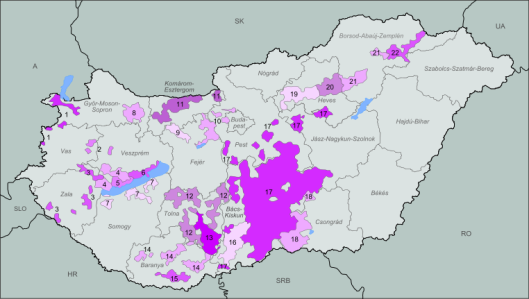Tags
Tokaji, Tokaji, Tokaji. If you search for Hungarian wine that is often what you find. But the fact is there are currently 22 wine regions in Hungary. And Takaji is wine from one of those regions amongst the 22. And depending on your wine tastes, maybe not even the most desirable.

Wine regions of Hungary. (citation: from Wikipedia using the GNU Free Documentation License, Version 1.2)
I have almost come to the point that if anyone mentions Tokaji (or Tokaj) I roll my eyes. With the mere mention of that region in singularity I can but assume the speaker knows next to nothing about the wine culture in Hungary. I know that sounds harsh, but I am going to be frank about this. It is like thinking Napa is the one and only best wine region in California. Yet there is indeed great diversity in California and many different areas of the state have high quality wines to offer. I personally, for example, find many of the wines from some vineyards in the Alexander Valley of Sonoma County to be far superior to many Napa wine offerings. Things are changing in recent years, but Napa still gets a disproportionate amount of the common press and cognitive association as what is a Californian wine. If I see a Californian wine in a grocery store in Hungary, it is most often from Napa. Unfortunately advertising, marketing, and fame (deserved or not) too often trumps local knowledge.
Tokaji was given the Protected Designation of Origin by the EU, and justly so for this region’s famously sweet aszú (botrytised) wine. But like all “special designations“, the follow-up exploitation of that designation for regional or national purposes may ignore a greater reality. The result is too often less support or equal press for other regions that may even produce a better product (depending on personal tastes and preferences of course). Even the other non-sweet Tokaji wines offerings are too often ignored in my opinion.
Tokaji is a Hungarian wine, but Hungarians wines are indeed more that just Tokaji. The Hungarian wine diversity is extensive, yet it seems to be unfortunately under appreciated and internationally unknown and ignored.
Let me try to correct that with a few examples:
- Badacsony Wine Region (5 in the map above) – North shore of Lake Balaton. Grapes have been grown here since Roman times. The dominate wines include whites such as Pinot Gris (Szürkebarát), Tramini, Ottonel muskotály, Rajnai rizling, Chardonnay. and Kéknyelű. The Pinot Gris was a reported to be a favorite wine of Charles the IV, but there are some new vintners who have done some amazing things with some red wines.
- Balatonfelvidéki (4 in the map above) – Near the Badacsony wine region above so many of the wines offered overlap. But the calcareous soils here differ from the nearby basalt/clay soils of the Badacsony region nearby, giving a distinctive wine styles within a short geographical distance. My wines of choice and recommendation here are Green Veltelini (Valtellina), Israi Olivér and Cserszegi Fûszeres . Csersziegi Füszeres (a fresh spicy white) is a Hungarian local variety that was actually developed in this wine region.
- Villány (15 in the map above) – Here you will find robust, full-bodied, spicy reds. Cabernet Franc has found its second home here in Villány. If you were to try just one Hungarian wine, I but can suggest the Cabernet Francs from Villány.
- Soprón (1 in the map above) – Kékfrankos (Blaufränkisch, or Lemberg in the USA) and Merlot are good wines from this region boarding Austria. Definitely worth a try, with the current quality to price ratio of some wines form this region being hard to beat.
- Somló (2 in the map above) – Many varietal vines, but also famous for its regional cuvée and blended wines that are said to be the perfect match for Hungarian cuisine.
Both large and small vineyards can be found in all the regions I listed above. Giving the opportunity for some really personalized wine tasting experiences and exploration. Don’t be afraid to walk up and knock at a door that looks like it may have a cellar and people appear to be there to greet you. Hungarians, including many semi-hobby (small scale but still may sell wine) wine makers, are often happy to have you taste their wines. Also be prepared to sit and visit if you are so favored and invited from a small producer. Wine drinking is a social event here, and visiting for a while over a glass, if offered, is polite and expected. You may not get to explore too many cellars this way, lingering over a glass (or two) of wine at each, but it is a truly splendid way to spend a day and maybe acquire some good wine.
And that word “exploring” is important. Wine, in my opinion, is all about exploring. So don’t be afraid to check out the many wine regions of Hungary and the many small and large cellars this country has to offer. Meet new wine regions, meet new wines, and meet new people.
Transportation options around Hungary are at the tourism menu above, which I am repeating below for convenience. There is a zero blood alcohol tolerance for drivers in Hungary (if you drink at all, you can not drive). So take a bus or train, enjoy your wine tasting, and let others do the driving:
Key for the above site:
VOLÁN = Bus
MÁV = Train
BKV = Budapest transportation portal
MAHART = Ferry boats (river and Lake Balaton)
I find the Bus (Volán) to be usually the cheapest option for transport around Hungary, and it also has the greatest diversity of destinations.

Pingback: Weather That Is Good For Mushrooms Is Bad For Wine | Crafting wine, life and home in Hungary